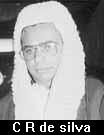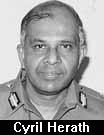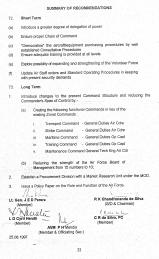



![]()




 As
billions of rupees of the nation's money is being poured into the country's
war effort, the role played by the Sri Lanka Air Force, has come into sharper
public focus again.
As
billions of rupees of the nation's money is being poured into the country's
war effort, the role played by the Sri Lanka Air Force, has come into sharper
public focus again.
Revealed exclusively today in Situation Report -Special Assignment (Page 6) are findings of a top level Committee appointed by President Chandrika Bandaranaike Kumaratunga. It was appointed to probe how 16 aircraft belonging to the Sri Lanka Air Force crashed between a period of April 1995 and May 1997.
The Committee was headed by the country's top most official in the security establishment, Defence Secretary, Chandrananda de Silva and comprised General Denis Perera, a former Army Commander, Air Vice Marshal Pathman (Paddy) Mendis, a former Air Force Commander, Cyril Herath, a former Inspector General of Police and C.R. de Silva, Additional Solicitor General.
The Committee has made a series of strong strictures both in respect of procurements as well as the role played by the Commander. Since the string of air crashes and the resultant developments have been a matter of great public concern, the findings of the Committee have been reported in detail.
 As stated earlier,
the Committee's task was only confined to ascertaining how 16 air crashes
occurred during a period of just two years. A significant feature of its
findings has been the fact that procurements had been made without tender
procedures. This was under what was categorised as 'crisis purchases.'
As stated earlier,
the Committee's task was only confined to ascertaining how 16 air crashes
occurred during a period of just two years. A significant feature of its
findings has been the fact that procurements had been made without tender
procedures. This was under what was categorised as 'crisis purchases.'
As repeatedly stated in these columns, the 'crisis purchases' by security forces top brass were allowed after peace talks between the People's Alliance Government and the Liberation Tigers of Tamil Eelam (LTTE) failed.
Convinced that there were no prospects for a negotiated peace settlement, PA leaders decided to step up the military offensive against the LTTE. Since tender and other procedures were time consuming, security forces top brass were allowed to import whatever they wanted directly.
Three years after this was allowed, glaring instances of obsolete, unusable equipment and military hardware being imported to fight the Tiger guerrillas has come to light periodically. In addition there has been numerous instances of items being ordered far in excess of the required quantities. Such acquisitions have been made by the Army, Navy and Air Force.
In the case of the Army, I pointed out in these columns how 24 Mortar Locating Devices purchased at a cost of US dollars 15 million (or Rs 870 million) are lying idle. This equipment would have helped identify and neutralise enemy mortar positions. In the ongoing "operation Jaya Sikurui" (or Victory Assured) which is on its 166th day today, the largest number of casualties including deaths have been caused by mortar shell injuries. Needless to say lives and wounds could have been saved. The move has prompted Army authorities to spend more money to procure these devices urgently. This is just one example.
Similarly, the Sri Lanka Navy ordered an enormous quantity of ammunition from an Asian country (including 37 mm and 25 mm) said to be worth over Rs 3.5 billion. The move triggered off a top level inquiry after reports that the stock could have lasted well over a decade. During that time the Navy would have scrapped the guns that fired these shells.
In the Sri Lanka Air Force some of the "crisis" purchases have not only run into billions of rupees but the items have either been lying idle or hardly used. Though the top level Committee only probed the air crashes, it has recommended on the need to "democratise" the aircraft/equipment purchasing procedures by well established Consultative Procedures.
Needless to say that the Committee's recommendation clearly underscore the serious concern over "crisis" purchases. In the case of the Sri Lanka Air Force, sections of the defence establishment believe there is a need for another Committee to probe millions of dollars worth of equipment purchases. The idea is to ascertain whether the items obtained were suitable and whether they were cost effective.
Details of some of these procurements have been revealed on this page. One was the purchase of a Laser Designator with guided bombs at a cost of US dollars 3,761,000 (or over Rs 200.8 million). This piece of sophisticated equipment has been lying idle in an SLAF warehouse. Soon after this was reported in The Sunday Times, top brass were ordered to return it to the supplier.
It seemed highly unlikely the supplier would take the item. Even if it did, an interesting question would be the one involving commissions. He would not be refunding commissions connected with the deal. A similar situation arose when the Army purchased Direction Finding (DF) equipment from an European supplier four years ago. When it was found that the equipment was not functioning, it was returned to the supplier. They agreed to replace the equipment but the cost was worked out minus the commission that has been paid during the previous deal.
Another was the purchase by the SLAF of Airborne Surveillance System for the SLAF's only Beechcraft at a cost of US dollars 6,374, 000 (or over Rs 377 million). Until The Sunday Times revealed this last Sunday, the aircraft lay on the ground. It had not flown more than four sorties a month.
Last week's exposure has jolted the top brass into action. The Beechcraft is now airborne for four hours every day. Instructions have also gone out that pilots be trained immediately to fly this aircraft.
But these are not the only crisis purchases by the SLAF. There are many, many more. Take for example the purchase of anti missile systems for F 7 aircraft (Order No: M-296 / Letter of Credit No: 95/52873) for US dollars 1,727,250 (or over Rs 102 million).
The brand new systems were fitted to four aircraft. Believe it or not, the four are on ground. Insiders say they have not flown an operational sortie for well over six months.
Another is the purchase of 20 bombs to destroy airport runways. These bombs acquired from an Asian country is the European equivalent of Durendal. The SLAF ordered 20 of them (Order Number Y 6064) at a cost of US dollars 26,400 each. The entire quantity cost US dollars 528,000 (or over Rs 31 million).
Whose airport runways were to be destroyed with these bombs, I asked an SLAF source. He said there had been intelligence reports that the LTTE was building a runway near the Iranamadu tank in the Wanni. "so we were ready if and when a runway came up," he pointed out.
Military Intelligence sources confirmed reports that the LTTE, three years ago, had cleared a patch of land that resembled a runway. It was not metalled or tarred. There were fears the area may have been intended for an air drop of weapons. The situation was closely monitored but nothing happened, said an intelligence source. "Using those bombs to destroy a clearing is like striking a fly with a sledge hammer," he pointed out.
Notwithstanding all this, there was another interesting feature about these Durendal type bomb. An aircraft taking on a target (a runway) will have to release this bomb at an altitude of 250 feet. It does not take an expert to say that at such an altitude, the aircraft will come under sure enemy fire. These 20 bombs are also lying in an SLAF warehouse.
One more example is the acquisition of Satellite Imager System at a cost of US dollars 4,445,000 (or over Rs 261 million). SLAF sources say a similar unit is already available with the Mahaweli Authority at Polgolla and could have easily been used. They ask whether such an enormous investment was really necessary.
The entire procedure of procuring equipment for armed forces is open to question and now a matter of public concern. Equipping the forces is a calculated process of decision and selection. Arising from the operational need of equipment for specific roles the ultimate choice of equipment depends on many factors. Amongst these are task suitability, desired level compatibility and costs of both purchase and operation. Furthermore considering inter-service operations the selection of equipment merits that the choice of hardware should satisfy the strategic and tactical requirements of the collective role of the armed forces. The entire procedure is a balance of operational and technical suitability, logistical simplicity and financial affordability.
The fast track procurement process as a result of the carte blanche license given by the government in view of the haste to update equipment to meet the requirements of the Eelam War Three resulted in the rationale of procurement procedures being thrown to the winds. Procurement appears to have been done on an adhoc basis. To put it mildly it seems to have been at the will and fancy (and perhaps to the gain) of a few, in scant disregard to laid down principles, precedures, or operational factors. This situation led to the opening of doors to arms peddlers to attract intermediaries with promises of Committees and graft. Little wonder that the public are gravely concerned with the stories of neuvean riche military bureaucrats said to have lined their pockets at the expense of the country and the men who are fighting the war up in the front.
Now that the government has had a committee on matters of procurement etc. in the Air Force it is opportune that similar commissions be appointed in regard of procurements made by the other two services as well. It will also be salutory if the government identifies those, if any who have engaged in corrupt practices making commissions and deals. Those found so suspect should be dealt with by the established legal procedures for bribery and corruption. This will not only contribute to improve the morale of the services but it will also contribute to uplift public morale and the image of the government itself.
Return to the Editorial/Opinion contents page
![]()